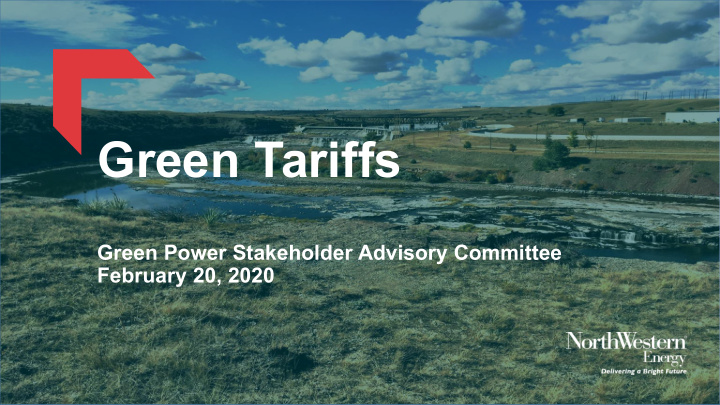



Green Tariffs Green Power Stakeholder Advisory Committee February 20, 2020
NorthWestern Energy’s Current Portfolio • NorthWestern’s current energy mix provides a significant first step for customers needing to meet sustainability targets. • 115 MW of renewables (nameplate) were added in 2018 (80 MW in December). • Nearly 700 MW of Qualifying Facility (QF) renewables (mostly wind) have, or will soon have PSC Orders setting terms and conditions (not all will be developed). 2
Green Tariffs Green Tariffs • A green tariff is a pricing structure offered by an electric utility (and approved by the regulatory commission), which allows eligible customers to source their electricity from renewable resources. • Through a green tariff, customers are able to purchase both the energy from a renewable energy project, typically at a large-scale, and the associated RECs. • Typically offered to provide larger commercial and industrial customers an option to meet their sustainability goals.
Green Tariffs Green Tariffs • Green tariffs can be used by customers to obtain up to 100% renewable power. • As measured on a kWh/MWh basis. • Also referred to as a “net” basis. • Program offerings vary by utility and customers’ needs. • The cost of a green tariff program is covered by program participants. • No cost shifting to non-participants.
Green Tariffs Green Tariffs - Considerations • Would be a new tariff offering for NorthWestern Energy. • Potential Considerations: • Various Terms (5-20 years). • Typically includes a bill credit. • Fixed or adjusted (annually). • Additionality, or not (or both). • Additionality is a term to mean that the tariff would result in the construction of “additional” renewable resources.
Green Tariffs Green Tariffs – Considerations (cont.) • Potential Considerations: • Utility scale, or not (or both). • Aggregation. • Customers at the project level, and • Metered loads at the Customer level. • Size limitation. • Low income participation. • Other considerations?
Green Tariffs Green Tariffs - Sleeved PPA • One particular form of green tariff. • Utility, or customer, arranges a Purchased Power Agreement (PPA) with an eligible renewable resource. • Energy and RECs, or possibly RECs only • Utility acts as a conduit, and passes through the cost of the PPA through to the customer(s).
Additional Resources Resources: • NorthWestern Backgrounder (provided with Agenda). • Dan Lloyd testimony and responses to data requests (provided by DEQ). • U.S. Electricity Markets: Utility Green Tariff Update. https://rebuyers.org/us-electricity-markets-utility-green-tariff-update/ • EPA – Green Power Partnerships. https://www.epa.gov/greenpower/utility-green-tariffs/ • Center for Climate and Energy Solutions. https://www.c2es.org/document/green-pricing-programs/ • NREL – Voluntary Green Power Programs. https://www.c2es.org/document/green-pricing-programs/
For Further Thought Corporate Renewable Energy Buyers’ Principles 1. Choice – Greater choice in renewable options 2. Cost competitiveness – More access to cost competitive options 3. Long-term pricing – Access to long-term, fixed-price contracts 4. New products – Reductions in emissions beyond business as usual 5. Financing tools – Increased access to third-party financing, standardized contracts, simplified processes 6. Cooperation – between utility, businesses, and regulators
Thank You
Recommend
More recommend